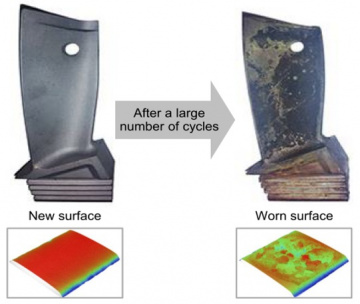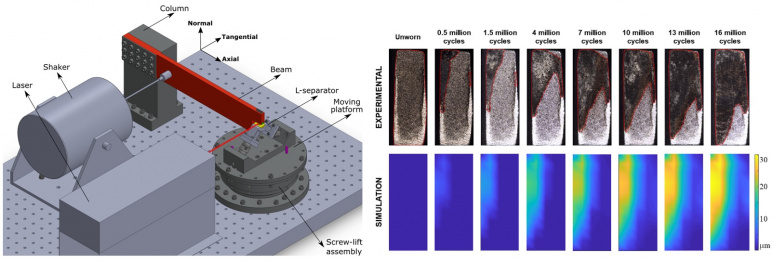ESR3 - Effect of wear on the dynamics of structures with friction contacts
Recruiting Institution/Company: Politecnico di Torino (Italy)
PhD awarded by: Politecnico di Torino (Italy)
Phd Thesis: Effect of wear on the dynamics of structures with friction contacts
A typical aeroengine is made of many assemblies such as multiple stages of turbine and compressor blades, whose components are connected by mechanical joints. These joints create interfaces which are subjected to various static and dynamic loads causing vibration during operation. The accurate prediction of operational vibration levels is critical because the components are designed to structural limits for performance and efficiency. The crucial contacts such as bladed disk shroud contacts, blade-root joints and under-platform dampers are designed carefully to provide friction damping by allowing micro-sliding at these contacts. However, the contact interfaces introduce nonlinearity due to friction and affect the dynamic response. The current linear solvers are not sufficient anymore, as the results lead to great simplification and do not reflect realistic scenarios. Hence, robust nonlinear solvers considering friction contacts are necessary.
The micro-sliding at the contacts leads to fretting wear and energy dissipation. The dissipated energy causes loss of material and alters the contact conditions (Fig. 1). These new contact conditions affect the contact preload conditions and alter the dynamic response, sometimes detrimental. The fretting wear and reducing preload conditions can change the dynamic behaviour of the blade. In extremities, the shrouded blade can act as a free-standing cantilever beam leading to unfavourable conditions. Therefore, the robust routines studying nonlinear dynamic behaviour including the effect of fretting wear and the evolution of the contact interface with changing preload are highly necessary today.

Fig. 1: Degradation due to operation
The objective of this project is two parts - numerical and experimental. The numerical part is to develop a prediction tool to simulate the nonlinear behaviour arising due to friction contact and study the impact of fretting wear and changing preload. This is achieved by developing a coupled harmonic balance method (HBM) with a 2D Jenkins element contact model and adding a wear model using wear energy approach and an adaptive wear logic to simulate accelerated wear. The prediction tool is studied on various numerical test cases, including a realistic turbine bladed disk with shroud contacts. The software is developed in MATLAB and is optimized to run on a super-computer.
For the experimental part, a novel forced response test rig (Fig. 2(a)) is designed to simulate a friction contact with varying preload arising due to fretting wear. The test rig design, instrumentation, system identification and a set of long-term results until full loss of contact are presented. Next, the effect of fretting wear on the friction contact evolution, hysteresis loops, contact preload and the impact on the evolution of system dynamics are captured and discussed in detail. The experimental results are then validated with the numerical prediction from the developed HBM tool. The experimental result and the equivalent numerical prediction of contact interface evolution is shown in Fig. 2(b) as an example.

Fig. 2: (a) Novel forced response test rig (b) Experimental and numerical prediction of contact interface evolution
